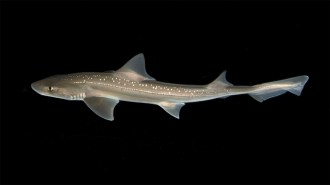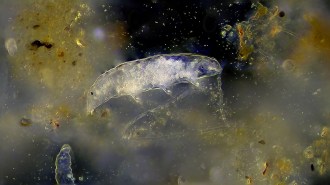Uncategorized
-
 Space
SpaceJWST spots the earliest sign yet of a distant galaxy reshaping its cosmic environs
The galaxy, called JADES-GS-z13-1, marks the earliest sign yet spotted of the era of cosmic reionization at 330 million years after the Big Bang.
-
 Genetics
GeneticsWhat 23andMe’s bankruptcy means for your genetic data
As 23andMe prepares to be sold, Science News spoke with two experts about what’s at stake and whether consumers should delete their genetic data.
-
 Animals
AnimalsYou might be reading your dog’s moods wrong
A dog's physical cues often take a back seat to environmental ones, skewing humans' perceptions, a small study suggests.
-

Math puzzle: The Lesser Fool
Solve the math puzzle from our April 2025 issue. In honor of April Fools’ Day, we offer the puzzling case of the Lesser Fool.
By Ben Orlin -
 Animals
AnimalsIs that shark ticking? In a first, a shark is recorded making noise
The ocean can be a symphony of fish grunts, hums and growls. Now add tooth-clacking sharks to the score.
By Susan Milius -
 Plants
PlantsA nearly century-old dead date palm tree helped solve an ancestry mystery
The iconic Cape Verde date palm came from commercial trees gone feral and could provide genetic variety to boost the resilience of its tamer relatives.
By Susan Milius -
 Animals
AnimalsA tardigrade protein helped reduce radiation damage in mice
Mouse cells tweaked to produce the tardigrade protein incurred less DNA damage than unaltered cells — hinting at a new tool for cancer patient care.
-
 Health & Medicine
Health & MedicineTuberculosis could be eradicated. So why isn’t it?
John Green’s new book, Everything Is Tuberculosis, reveals how social injustice sustains the disease, despite available cures and vaccines.
-
 Agriculture
AgricultureHow silicon turns tomato plants into mean, green, pest-killing machines
Treated plants fight pests without the need for toxic pesticides, oozing a "larval toffee" that stunts tomato pinworms’ growth and attracts predators.
-
 Climate
ClimateBuying carbon credits to fight climate change? Here’s what to know
Carbon credits sold on the voluntary market are under scrutiny for not offsetting greenhouse gas emissions as claimed.
-
 Health & Medicine
Health & MedicineAvoidable deaths increased in the U.S. as they dropped elsewhere
In the United States, deaths that could have been avoided rose, on average, from 2009 to 2019. That’s in contrast to European Union countries.
-
 Health & Medicine
Health & MedicineA deep brain stimulation volunteer discusses life after depression
In this bonus episode of The Deep End, you’ll hear an update from Jon Nelson, who is living what he calls his "bonus life."